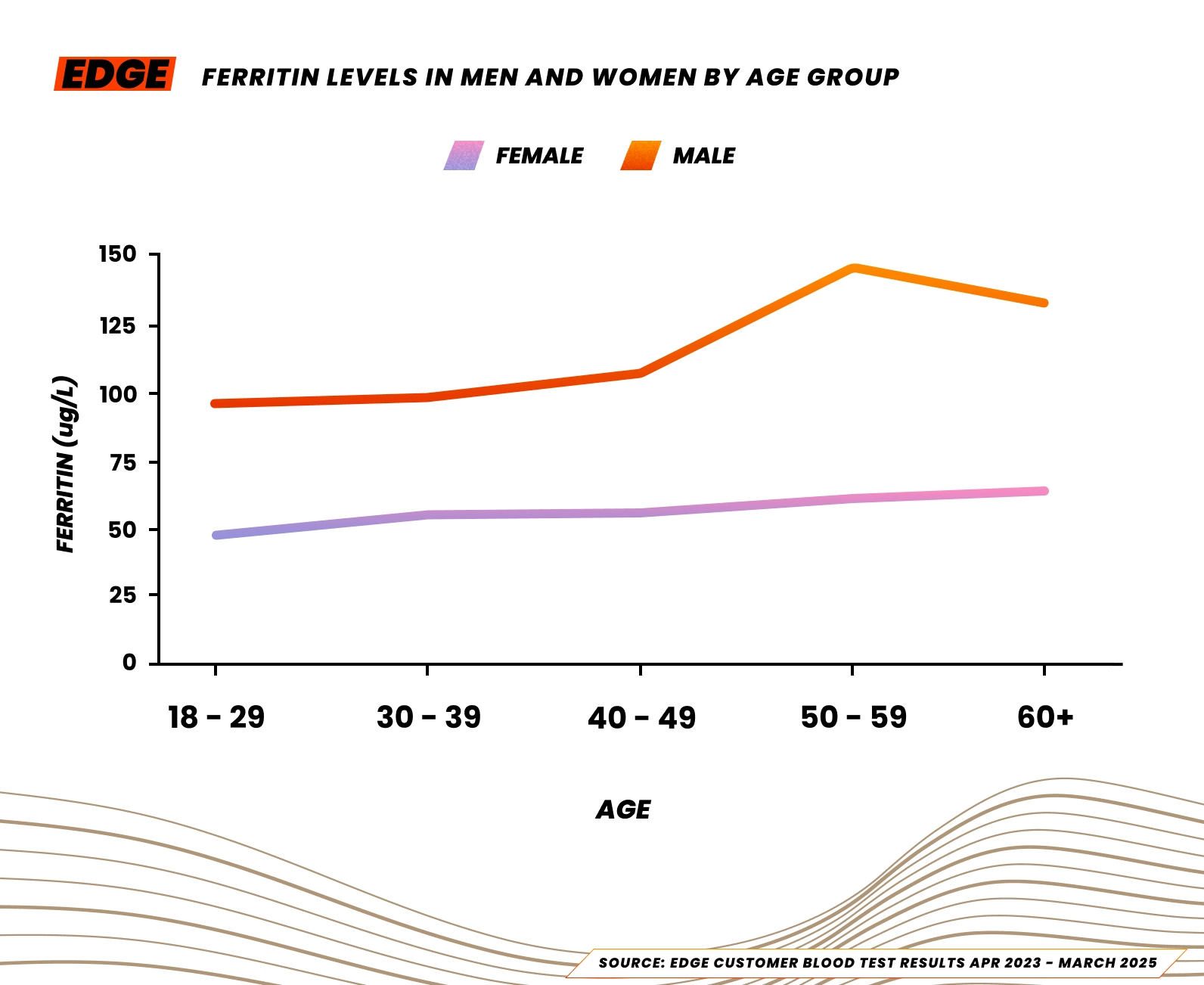What is Ferritin & why is it important for athletes?
1 min read
Published on
May 22, 2025
Written by
EDGE
Share this article
What Is Ferritin?
Ferritin is a blood protein that transports iron, making it a vital marker of your body’s iron reserves. For athletes, especially endurance and female athletes, the overall iron status, reflected by ferritin, is closely tied to red cell production which impacts oxygen delivery, energy, and performance capacity. However, iron is ubiquitous in the body and is also involved in immune function, hair health, sleep and even thyroid function.
Low ferritin levels can silently sap endurance, delay recovery, and increase fatigue, long before anaemia develops. That’s why ferritin is one of the most important biomarkers to monitor regularly in sports.

"Ferritin is a good surrogate marker of your stored iron, which is essential for oxygen transport and energy production. Low ferritin can impair endurance and recovery, a common issue, particularly among female athletes and endurance runners. I advise testing every 3–6 months, and pairing it with haemoglobin, transferrin saturation, thyroid panel and Active B12 to assess iron status comprehensively and detect early signs of deficiency."
What’s the difference between ferritin and iron?
Iron is essential for making haemoglobin – the protein in red blood cells that delivers oxygen to your muscles during exercise. If iron is low, oxygen transport suffers, and so does your performance.
Ferritin, on the other hand, is your iron storage. Think of it as your backup supply. You can have normal iron levels in your blood, but still be running on empty if your ferritin is low.
For athletes, that matters. Low ferritin can mean reduced endurance, slower recovery, and unexplained fatigue – even if your iron levels look ‘fine’.
Regular blood testing helps you spot these subtle imbalances early, so you can take action before performance dips.
What are normal Ferritin levels for athletes?
We looked at blood test data from EDGE customers and found the median ferritin levels for men and women are 108 ug/L and 55 ug/L, respectively. These levels are important for athletes who are training consistently. Although the lab ranges are very wide, there are clear recommendations that levels should be a minimum of 50ug/L before any altitude training or high volume aerobic training is completed due to the increased demands on the erythro/leukopoietic system.
Here is a breakdown of ferritin levels by age and gender:
| Table 1: Ferritin Levels in Men and Women by Age Group (ug/L) | ||
| Age Group | Female | Male |
| 18-29 | 48.4 | 97 |
| 30-39 | 54 | 99 |
| 40-49 | 54.5 | 108 |
| 50-59 | 66 | 143 |
| 60+ | 67.8 | 133.5 |
Source: EDGE customer blood test results Apr 2023 – March 2025
The labs we used to analyse blood samples state a healthy range for ferritin is between 13-150 ug/L for women and 30-400 ug/L for men.

Why Athletes Are at Risk
-
Higher Iron Turnover
Training increases red blood cell production, raising iron demands. Iron is also lost through sweat, urine, and gastrointestinal microbleeding, common during long-distance running.
-
Restricted Diets
Vegan and vegetarian athletes may not get enough iron or absorb it efficiently due to the absence of haem-iron (the easily absorbed form found in meat).
-
Female Athletes
Menstrual blood loss significantly increases iron requirements. Active women are at high risk of iron depletion, especially if training intensifies without nutritional support.
-
Inflammation from Training
Inflammation can raise ferritin temporarily while simultaneously blocking iron availability, masking an underlying deficiency unless testing is correctly interpreted.
Symptoms of Low Ferritin
-
Fatigue during or after training
-
Declining endurance or VO₂ max
-
Restless legs or heavy limbs
-
Poor recovery and increased breathlessness
-
Recurrent injuries or illness
These symptoms are often dismissed as overtraining or lack of sleep, when the root cause may be low iron stores.
When Should Athletes Test Ferritin?
-
During pre-season, training blocks, or after unexplained fatigue
-
If symptoms of low iron appear
-
When changing diet (e.g. reducing meat or going plant-based)
-
As part of routine blood health monitoring for endurance athletes
Testing ferritin, alongside haemoglobin and full iron studies, gives a complete picture of iron availability.
How to Raise Ferritin Levels
-
Eat iron-rich foods (red meat, poultry, oily fish, lentils, spinach)
-
Combine plant-based iron with vitamin C (e.g. orange juice) to improve absorption
-
Avoid tea/coffee with meals, which can block iron uptake
-
Consider iron supplementation if recommended by a clinician, but only after testing
Supplementing without knowing your levels can lead to iron overload, which also affects health and performance.
In Summary
-
Ferritin reflects stored iron which is important for energy, oxygen transport, and endurance
-
Low levels can reduce performance before anaemia is detected
-
Female and endurance athletes are especially vulnerable to deficiency
-
Testing is key for prevention, early detection, and personalised nutrition
Check Your Ferritin Levels
Don’t wait until you’re running on empty. Check your ferritin to stay strong, energised, and competition-ready.
Get 10% off your first order
Want regular tips on how to make the most of your results? Join our newsletter and we'll give you 10% off your order!
Get the knowledge
Get expert advice to help you improve your results.
Go to our knowledge center
Fat Burning: The Cold, Hard Truth
Nutrition

What is Runner's knee?
Running

